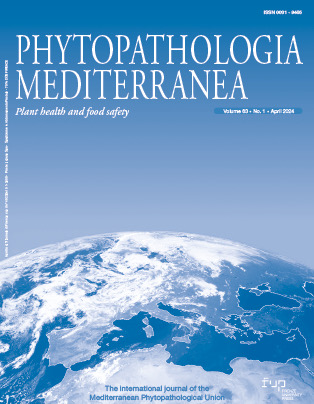Published 2024-02-17
Keywords
- PrVI,
- Bromoviridae,
- Clematis spp,
- high-throughput sequencing,
- emerging viruses
How to Cite
Copyright (c) 2024 Giuseppe PARRELLA, Elisa TROIANO, Anna MIGNANO

This work is licensed under a Creative Commons Attribution 4.0 International License.
Abstract
Prunus virus I (PrVI) was detected for the first time in Clematis vitalba in Italy using high-throughput sequencing and the complete genome of this isolate, named Clv-1, was assembled and characterized. The results of the bioinformatic analyses were further validated with RT-PCR assays using PrVI-specific primers and Sanger dideoxy sequencing. The Clv-1 genome included three RNA segments of nucleotide lengths of 3468 (RNA1), 2892 (RNA2) and 2225 (RNA3), with five predicted open reading frames. Phylogenetic analyses showed close relationships with other PrVI isolates from different geographical origins, including European and non-European countries. This new pathogen record extends the information on the geographical distribution of PrVI, and possibly reflects the international movement of infected clematis germplasm due to global trade. Further surveys on the presence and distribution of PrVI in weeds and crops, such as the two PrVI hosts sweet cherry and peach, are required in the countries where PrVI has been detected.
Downloads
References
- Angelini E., Squizzato F., Lucchetta G., Borgo M., 2004. Detection of a phytoplasma associated with Grapevine Flavescence dorée in Clematis vitalba. European Journal of Plant Pathology 110: 193–201. DOI: https://doi.org/10.1023/B:EJPP.0000015361.95661.37
- Bankevich A., Nurk S., Antipov D., Gurevich A.A., Dvorkin M., … Pevzner P.A., 2012. SPAdes: a new genome assembly algorithm and its applications to single-cell sequencing. Journal of Computational Biology 19(5): 455–477. https://doi.org/10.1089/cmb.2012.0021. DOI: https://doi.org/10.1089/cmb.2012.0021
- Chirkov S., Zakubanskiy A., Sheveleva A., Zubkova N., Mitrofanova I., 2022. Detection and molecular characterization of viruses infecting clematis in Russia. Journal of Plant Pathology 105: 173–183. https://doi.org/10.1007/s42161-022-01242-8 DOI: https://doi.org/10.1007/s42161-022-01242-8
- Edgar R. C., 2004. MUSCLE: multiple sequence alignment with high accuracy and high throughput, Nucleic Acids Research 32(5): 1792–1797. DOI: https://doi.org/10.1093/nar/gkh340
- Mitrofanova I.V., Zakubanskty A.V., Mitrofanova O.V., 2018. Viruses infecting main ornamental plants: an overview. Ornamental Horticolturae 24: 95–102. DOI: https://doi.org/10.14295/oh.v24i2.1199
- Mitrofanova I., Ivanova N., Kuzmina T., Mitrofanova O., Zubkova N., 2021. In vitro regeneration of Clematis plants in the Nikita Botanical Garden via somatic embryogenesis and organogenesis. Frontiers in Plant Science 12: 541171. https://doi.org/10.3389/fpls.2021.541171 DOI: https://doi.org/10.3389/fpls.2021.541171
- Orfanidou C.G., Xing F., Zhou J., Li S., Katis N., Maliogka V.I., 2021. Identification and sequence analysis of a novel ilarvirus infecting sweet cherry. Plants 10: 514. https://doi.org/10. 3390/plants1003 0514 DOI: https://doi.org/10.3390/plants10030514
- Parrella G., Troiano E., 2022. A New Ilarvirus Found in French Hydrangea. Plants 11(7): 944. https://doi.org/10.3390/plants11070944 DOI: https://doi.org/10.3390/plants11070944
- Paytuví A., Battista E., Scippacercola F., Aiese Cigliano R., Sanseverino W., 2019. GAIA: an integrated metagenomics suite. bioRxiv 804690. https://doi.org/ 10.1101/804690 DOI: https://doi.org/10.1101/804690
- POWO (2023). Plants of the World Online. Facilitated by the Royal Botanic Gardens, Kew. Published on the Internet; http://www.plantsoftheworldonline.org/ Retrieved 27 November 2023.
- Rivarez M. P. S., Pecman A., Bačnik K., Ferreira O. M. C., Vučurović A., … Kutnjak D., 2022. In-depth study of tomato and weed viromes reveals undiscovered plant virus diversity in an agroecosystem. bioRxiv 2022.06.30.498278. https://doi.org/10.1101/2022.06.30.498278 DOI: https://doi.org/10.1101/2022.06.30.498278
- Salamon P., Nagyne-Galbacs Z., Demian E., Achs A., Alaxin P., … Varallyay E., 2023. Clematis vitalba Is a Natural Host of the Novel Ilarvirus, Prunus Virus I. Viruses, 15: 1964. https://doi.org/10.3390/v15091964 DOI: https://doi.org/10.3390/v15091964
- Tamura K., Stecher G., Kumar S., 2021. MEGA11: Molecular Evolutionary Genetics Analysis version 11. Molecular Biology and Evolution 38: 3022–3027. DOI: https://doi.org/10.1093/molbev/msab120






